A Book on Constellations
Beautifully bound, this tome holds pictures of the common constellations sorted by Realm, and the stories behind their creation.

The gods have long spoken to those they have created and those that they reign over in a variety of ways. One is through the working of Divine Stars into various constellations, as reminders or omens, symbols of the past, or warnings of things that have happened or things that may come to pass.
The page below will be separated by Realm, holding the constellations found in each world. Keep in mind that stars that make up these constellations are Divine Stars and cannot be manipulated by anything other than a Greater God. This includes Ethers and Celestial/Cosmic dragons, and any character with powers that relate to the stars and heavens above.
There are currently no constellations that exist outside of a Realm Sphere, and all constellations stay within their Spheres until such time as the Realm itself is completely destroyed. Divine Stars in these constellations have even been seen in Realms, such as Kurai, that have no other stars, created by the gods after the regular Realm Stars have been swept away.
Constellations can appear and disappear at a god’s discretion, and may appear to individuals or an individual at any time or place, though they will usually have a fixed position in the cosmos and do not appear in the daytime (unless otherwise stated).
The Light Realm, Dark Realm, Soulplane, Ghost Realm, Highrealm, and Hell do not have constellations.
Realm: Evylon
The divine constellations of Evylon were once created by gods who no longer are; new constellations are added by Greater Gods, as the Old Gods are now gone. They shine brightly, with some oddly colored and incredibly bright. Most may shine through the magestorms unhindered.
Crown of Halgiana

While today they are a mighty race, ruling over a powerful empire, the Halgians came from humble beginnings. A human woman named Halgiana, gifted with potent light magic, was born long, long ago in Evylon to a family of no great distinction. While much of her youth remains lost to history, what is known is she was righteous of heart and uncompromising of spirit.
During a war between orc and the elves of Heartwood, Halgiana gathered together a band of volunteers who shared her unwavering spirit and joined the elves. As her fame grew, more and more people, mainly humans, flocked to her banner, until she commanded an entire army. She was greatly honored by the elves, although there were elves who feared and some of her followers who suggested that she should take over Heartwood, or found her own kingdom independent of elven rule in Shi'vrann'aeli.
She refused, and instead led her army to an unclaimed to the north-east. It was during this journey that it is said she and her followers were remade into Halgians, blessed by the gods, or by Daama herself, according to differing tales. But, however it may have happened, Halgiana established a new city, Illus-Adamar, and laid claim to the entire continent.
It was shortly after this that the elves of Heartwood sent her a gift; a number of pure white gemstones that seemed to glow with their own internal light. Halgiana had the gems inset into a crown of gleaming divine metal. Blessed with a greater lifespan than any human, as were all her kind, she lived a long life, and under her firm, just rule, the kingdom she had founded expanded to become a true empire.
After her death, a starry image of her crown, as famous as the First Empress herself, appeared in the night sky above the empire she had overseen for so long, serving as an ever-present reminder of her life and accomplishments.
Driakkion Supervolcano

Evylon has long ever been a dangerous, unforgiving place for its inhabitants. Highly aggressive wild beasts, ever-present Mage-storms, and the mutating essence of the Realm itself are just a few of many hardships the inhabitants of Evylon face. But all who were alive at the time remember the Dark Years.
In days long past, the land that is now Driakkion, home of the dragons, was once crowned by a massive, volcanic mountain range. But nobody knew that what appeared to be several separate volcanoes was, in truth, one single, massive volcano of unrivaled size. One that had been slowly gathering energy as the magma beneath it expanded, causing the mountains above to shake, rise, and finally crack under pressure.
When it erupted, nobody on Evylon was prepared for how powerful it was, or the effects it would have upon the Realm. People on Shi'vrann'aeli, and within the Halgian Empire, heard it explode, and great waves slammed into the coasts from across the sea. A great cloud of ash was hurled into the sky, and spread, blanketing the Realm in darkness, and leaving the survivors of the catastrophe to rebuild as best they could.
The resulting volcanic winter was known as the Dark Years, as the ash turned even the brightest day into an unnatural twilight. Ash fall turned once-verdant fields barren, and even the summer months failed to bring warmth to the lands. But the Mage-storms, normally a bane upon the Realm, caused the ash cloud to dissipate as they swirled and surged, causing breaks in the cloud that only grew, returning light and warmth to the Realm.
And there in the night sky, after the ash had faded and allowed the stars to shine brightly once more in the night sky, was a new constellation. The image of a great mountain, erupting with fire, was there for all to see, so they could remember what danger lies beneath Driakkion, ever-present, but long kept dormant by the power of the dragons living there.
The Winged Deer

Today, the elves of Heartwood are masters of a truly mighty land, their forests and cities kept safe by powerful magic and ever-vigilant rangers. But such was not always the case. There were times when their vigilance was tested and found wanting. The first great conflict between elves and orcs on Evylon was one such time.
A small but fierce band of orc raiders managed to fight its way into the city of Heartwood itself, and stormed the palace, intending to slaughter the ruling family and the rest of the city leaders, while outside the city a large army fought the elves and drove them back, their ferocity and bloodlust catching the elves by surprise.
But for all their careful planning and swift action, the orcs failed to catch the lord of the city. As the orcs had been storming the walls, a small group of sky deer, led by a mighty winged stag, had carried the lord and his family from the city and into the woods. Despite the large numbers of orcs within the forest, the deer easily avoided them, moving unseen by orc or even elf until they had carried the lord’s family to safety.
While the rest of the deer disappeared as quickly and quietly as they had appeared, the stag remained for a time, only leaving once the orcs had been defeated, and driven from Heartwood. Then he bounded off to the forest, and disappeared. But, not long after, the starry image of a great, winged stag appeared in the night sky, and from then on, a strong bond was formed between elves and deer of Heartwood, a bond that to this day remains unbroken.
Realm: Felnova
The constellations of Felnova were created by the Felnovian Five. As these constellations are newer than those from many other Realms, they gleam all the brighter in the night sky. Creation of these constellations has continued since the dawning of Felnova.
Reminder of the Gods

After the creation of Felnova was complete, the Five rested, and observed from afar as the people of the new Realm spread across their new home, exploring new regions and founding new settlements. The gods had done their jobs well, for there was great bounty in the land, and a new era of peace and prosperity had begun. Seeing this, the Five turned their attention to affairs beyond Felnova's borders, believing their new creation didn't need their direct oversight. For a time, they were right.
But as time passed, and the gods failed to make their presences known, people began to wonder where they had gone, and doubt their return. Many began to fear they had in some way angered or offended the Five, but their prayers went unanswered, apparently unheard. As the years went by, many began to lose their faith in the gods, and worship of other beings began. Cults centered around the Ether Spirit, the Realm itself, and even the First Royal Kazule, sprang up, despite attempts to quell them.
However, the Five had not abandoned Felnova. When they returned, they stilled the anger, the fear and recriminations, and the despair that had befallen the people, walking among them and assuring them they would never turn their backs on the Realm, even if they might at times be required to depart for distant Realms for long periods of time. None dared argue openly with this, but Time suspected many harbored doubts.
He gathered the rest of the Five, and they discussed what they could do for their people until, at length, they settled upon a solution. They crafted in the night sky an eternal reminder of their dedication to Felnova, a great dragon that would forever stand watch over the Realm below. These stars shine brightly in the sky, and can be seen from every part of Felnova.
The Five haven't always managed to walk among their people on Felnova as often as they may have preferred, but the gleaming reminder of their presences, shining brightly in the night, reassures people that their gods are there, and always will be.
Lion of the Stars
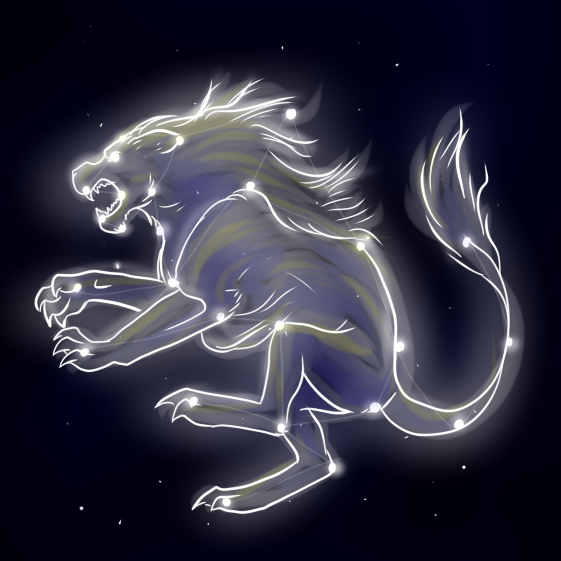
Long ago, when Azcen and his brother Nebrielas were still young, and mortal, the two lions wandered the Realms, learning what they could because the race of lions were still young, and their knowledge was limited. Azcen's hunger for knowledge was aided by Nebrielas' visions, so they always has something to learn no matter where they went.
However, although they both sought knowledge, their motivations were different. Azcen sought knowledge for its own sake, while Nebrielas sought knowledge for the betterment of his species. At times, Nebrielas would cease wandering so he could tell other lions all that he had learned and live among them, helping them as best he could with his newfound knowledge, while Azcen, on his own, continued his search for knowledge. Eventually, this endless thirst for learning caught Gaz'in's attention, and he watched the two brothers for quite some times.
He saw in Azcen a kindred spirit, and a fitting candidate for godhood. The Realm of Ristell was still young, and without gods, and the fiery lion was a strong candidate. However, when Gaz'in appeared to him, Azcen was reluctant to ascend and leave Nebrielas behind, despite his brother's encouragement to accept the great god's offer. For a brief time, Gaz'in withdrew to confer with the rest of the Ten, and returned with an offer for both of them to ascend to godhood; Azcen as part of Ristell's pantheon, and Nebrielas as the patron demigod of the lions of Vystriana. The brothers accepted this offer.
Nebrielas was made into a constellation, a starry lion roaring his defiance against the night sky, sleeping by day out of sight of mortal eyes. However, at times, these stars would vanish from the night sky as Nebrielas, taking on the persona of Aular, the Raizen of a pride of lions, walked among his mortal kin. These forays became longer and longer, and his divinity faded over time as he became mortal once again.
Eventually, he died of old age, but was reborn, and the cycle begun anew. A hundred times, he died, and was reborn, before reappearing in the night sky as Nebrielas. His power has faded, but he remains a guiding force in the lives of Vystrian lions, granting them visions and guiding them through dreams as he maintains his nocturnal vigil.
Wolves and Time
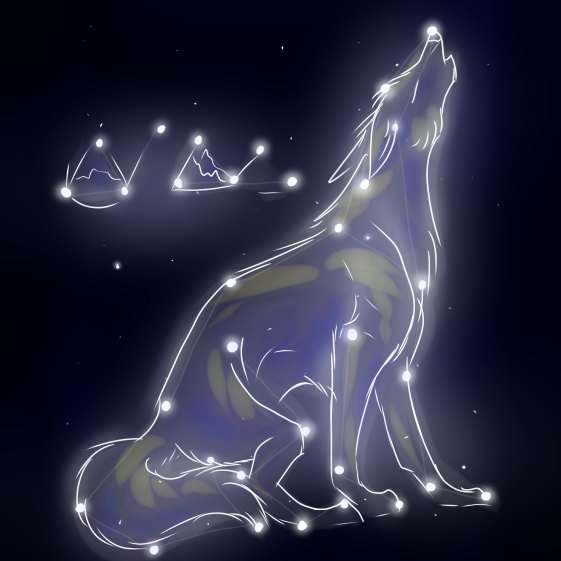
I'm sure you have heard the tale of Cirrus and R'rkain, and their fight for domination over all the wolves who live and breathe. Of how close the dark one to claiming victory over his brother. If not, well, that is a story for another day. But look to the sky, and gaze upon the wolf in the stars and the broken hourglass behind him, the symbol of Time's misjudgment, and the bond between brothers broken by that misjudgment.
You see, Cirrus and R'rkain Ascended during a dark time for our kind, and would be the cause of things getting darker still. For R'rkain was never supposed to Ascend in the first place. Time erred when he chose Cirrus, not knowing he was twin brother to R'rkain, so when Cirrus arose to godhood, so too did R'rkain.
For a time, it seemed as though Time's misgivings were baseless, as the twin gods ruled over the wolves and brought about a new era of stability and peace. But, alas, it was not to be. Cirrus, chosen of Time, forsook his brother's companionship in favor of bettering his people. R'rkain harbored resentment of his brother's authority and prestige, and a burning ambition to surpass his brother which was further fueled by what he saw as his brother's betrayal. He came so very close to succeeding, facing off against Cirrus in battle and gaining the upper hand.
But, at the moment of victory, while the Five watched in worry, he was ensnared and cast down, stripped of his power and divinity. Severely wounded, he fled, disappearing into the wilderness where he desperately sought to regain his lost power. But he retained his immortality, as Cirrus, despite urging from some of his kind to finish R'rkain off for good, couldn't bring himself to destroy his brother.
So, you see, the wolf gleaming in the night sky could be either Cirrus, mourning his lost brother, or R'rkain, crying out in anguish for what he lost. Or both, for as twins they shared a bond that could not easily be undone. As for R'rkain, he is still wandering the wilds, ancient but ageless, at the head of his own pack.
The Tree of Souls

At a time when Felnova was still young and the elves had only just begun to build their homes in the Song Forest, a guard by the name of Belgarath mourned his lost sweetheart. Though she had been gone for many years her betrayal still cut deeply, for they had been passionately in love when she had run off with another, far more wealthy man. At times he would go for days without speaking or eating and spent every waking moment by the tree he had planted in her memory, both missing her and cursing her name.
One day, as Balion observed the Realm, he noticed the elf kneeling by the tree and took an interest in his vigilance, coming to Belgarath in the form of an old man and asking what bothered him so. As he explained, the God decided he would find out what had become of the elf's love. It took him many years, for had other responsibilities that took precedence, but eventually Balion mentioned his search to the Goddess Linath who, after some thought, recalled that the elven woman had passed into the Soulplane over a decade past. She had stood out, the Goddess said, for she had seemed extremely sad, and when prompted about her condition explained that in order to save her lover from certain death she had given her own life.
The two Gods pondered this for some time, thinking how unfortunate it was that Belgarath had no way to know that his love had never truly betrayed him and had instead saved his life. Finally, they came up with a solution: combining their powers, they reached out and touched the elf's tree. Belgarath, who had been keeping his usual vigil, looked on in wonder as his tree and grew and warped, its trunk tripling in size even as the leaves took on a faint glow. When he reached out and touched it his love appeared beside him, as beautiful as she had been in life.
Much later in the day a huge congregation of elves stood in silent reverence around what had just been dubbed the Tree of Souls. Zacyn, looking down on them from far above, smiled. As night fell and the elves began to celebrate, one looked up and shouted with wonder, for in a patch of sky which had previously been quite bare of stars shone a perfect rendition of Belgarath's tree.
Forbidden Love

Not even the gods are immune to love, even among each other. Early in the history of the Fiv'ean Realms, Time, concerned about the impact it might have on the Balance, forbade the gods from having any offspring with each other. For a time, this command was followed. But love is not so easily controlled.
Zacyn and Scylla's love for each other grew, and, in secret, they began a tryst that eventually saw Scylla become pregnant. While they had managed to keep their budding romance a secret, Scylla's indiscretion was too much to hide from Time and the rest of the Ten. A furious argument erupted, during which Leartes promised to deal with their offspring himself if they proved to be a threat to the balance of the Realms, despite Zacyn and Scylla's protestations. After Fenrir supported Leartes, Time reluctantly supported him as well, although he decided to wait until the children had been born, and displayed their powers, before he passed final judgment. The rest of the Ten largely tried to remain neutral, though some made their feelings known, one way or another.
Several tense years followed, with the possibility of a fight between members of the Ten, which had previously been unthinkable, becoming a real, nightmarish reality. These offspring, a lightbeast named Daama, and a shadowbeast named Vladimir, grew to be powerful, but not unnaturally so. Leartes, seeing no threat, saw no reason to interfere, and Time, after reprimanding them, gave his blessing to Scylla and Zacyn and reversed his original decree.
As a reminder of the great power and influence of love, and of how close it had come to causing true strife among the Ten, he placed a a pair of starry dragons in the sky as further proof of his blessing upon their union.
Realm: Kurai
Kurai’s constellations were crafted by the Realm’s gods, though the first is said to have been created by one of the Greater Gods, and stand out in stark contrast to the otherwise starless sky. The light from the Red Moon casts a ruddy tint upon the stars.
The Four Lords

Though they had once lived in peace, the four tribes of demons were caught up in an enormously destructive war as their gods sought to eliminate one another, and seize complete control of the entire Realm. As the divine struggle went on, the demons marched to war. The conflict was long and bloody, made all the worse by the destruction the gods themselves caused.
An uneasy truce was declared after the gods ceased their fighting, but the four tribes, like their gods, had inflicted too much damage on one another to ever live in complete harmony again. The curses inflicted upon War and Death demons made peace all the more elusive. In the wake of the destructive war, chaos threatened to engulf the entire Realm at a moment’s notice.
In response, the Four organized their demons into separate Kingdoms, each led by a chosen Lord who had managed to win the favor of their respective gods. Neiren chose a fierce, mighty warrior with large horns on his head and long tail, named Neirakk, for his bravery in battle and expert leadership. Zailen chose Zail’khen, a tall, swift warrior with strong magical abilities who used his martial skills and magic skills in tandem, often leading swift, sudden strikes and devastating ambushes against his foes. Orphethas chose Galpheth, a cunning master of poisons and subtle tactics. Lethias chose Kalithia, a demoness with long, slender horns and broad wings, for her skills as a deadly, unrivaled assassin.
Although tensions remained high for many years, and occasional skirmishes broke out, these Lords, blessed with great power by their gods, kept order in their respective territories, and ensured that open warfare was kept to a minimum. As a sign of their authority, and their duty to maintain balance on Kurai, their starry images appeared in the dark sky, standing together, for all to see.
Neiren and Leithas

Once, during the early days of its existence, Kurai was not so different from other Realms. Stars filled the eternal night sky, and the trees bore fruits and leaves just as those of other Realms did. The four types of demons lived in peace, giving no thought to how they honored different gods, for they were all a part of Kurai.
But it wasn’t to last. Lethias’ pride grew into arrogance, and she began to view her fellow gods as her lesser, rather than her equals, and the desire to rule alone grew within her. She viewed Neiren as the greatest threat to her ambitions, and savagely attacked the goddess of War without warning, her desire to kill overriding her will to dominate all life. Caught by surprise, Neiren soon gave in to her bloodlust, fighting to destroy, not just to defend herself.
For days the goddesses fought one another, neither able to gain the upper hand, and neither willing to end it. But legend has it that Lethias broke off one of Neiren’s horns, and the great dragon tore a tuft of Lethias’ fur off as she struck back in furious retaliation. Thus, both were wounded in pride as well as body, and their conflict began to wreak havoc upon the very Realm itself, with great mountains and forest reduced to utter ruin.
Zailen and Orphethas, at first reluctant to intervene, saw as the demons they had all created began to fight among each other, mirroring their gods’ conflict, and witnessed the spreading destruction, felt they had no choice. At first, they fought to separate the two warring goddesses, but the dragoness and wolf turned their wrath upon the hawk and the lion, causing them to lose control in turn, and fight to kill.
The wars continued until the Four, grievously wounded and too exhausted to keep fighting, were forced to acknowledge that they were truly equals. But it was too late for them to go back to the way things were. Lethias and Neiren would be forever cursed for their part in starting the destructive conflict, and Zailen and Orphethas would never again be able to trust their fellow gods.
After the curse was inflicted upon them, starry images, created anew after the original stars were destroyed, appeared in the sky, an eternal reminder of how the dragoness and the wolf had brought ruin upon their Realm.
Zailen's Roar
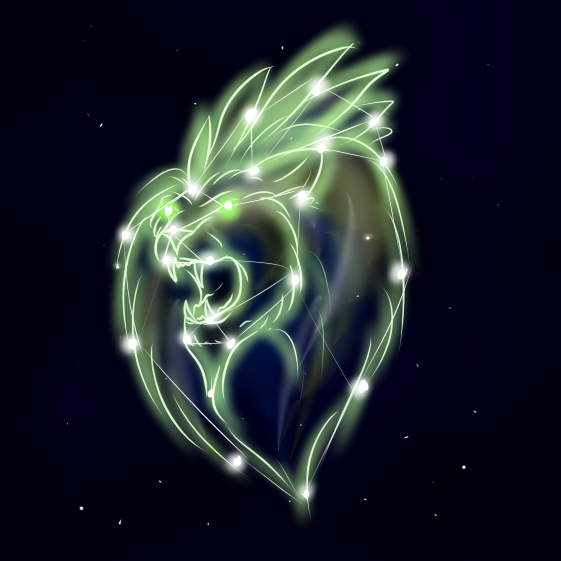
Famine Kingdom’s unique succession rituals provide both an advantage and an inherent weakness for its Lords. For, while the new Lords retain the wisdom and counsel of their predecessors, this requires the soul of the previous Lord be intact, and free. Thus it was kept a secret for a time. But even the deepest of secrets can be uncovered. Death Kingdom spies learned of this, and brought word to their Lord. Seeing an opportunity to greatly weaken if not outright destroy Famine Kingdom, the Death Lord formed a plan to disrupt the succession of the rival kingdom. Death-aligned raiders entered Noshinka and ransacked every small settlement they could find, even going so far as to attack Naraku. Outraged by this, Famine’s Lord decided to personally put an end to these raiders.
But this was the crux of Death’s plan. Once Famine’s Lord left the safety of the Famine Fortress, the raiders mounted and ambush, using powerful artifacts to weaken and bind Famine’s Lord before they escaped to Shinigami, with the Lord in tow. Once there, Famine’s Lord was murdered, and his soul sealed into a soulgem to prevent it, and the rest of the souls of past Famine Lords, from passing on.
Famine Kingdom, mourning the loss of their Lord, waited for a successor to be appointed, but without the souls of prior Lords, they waited in vain, growing ever more anxious and restless, until after many months a seer revealed what had happened. Enraged by this act of treachery, Famine, still leaderless, planned an expedition to Shinigami to recover their Lord’s soulgem from where it had been hidden, deep within Zugaikotsu.
By the time Famine’s soldiers landed, Death’s army was waiting, and though they fought fiercely, Famine’s soldiers were driven back, and forced to flee. Death, it seemed, had triumphed. But their victory celebrations were premature. The battle had been a feint, and a task force of Famine’s best ninjas infiltrated the great Skull City, eluding guards, citizens, and magic wards alike. By the time the Death and War demons supposed to be guarding the soulgem realized it was gone, so too were the ninjas.
As a new Lord was appointed, a great, starry image of a lion appeared in the sky. This was Zailen’s way of honoring his Kingdom, and boast about what they were capable of even without a Lord, for not only was Death’s plan thwarted, so too was their Lord greatly humiliated by this failure.
The Flames of Orphethas
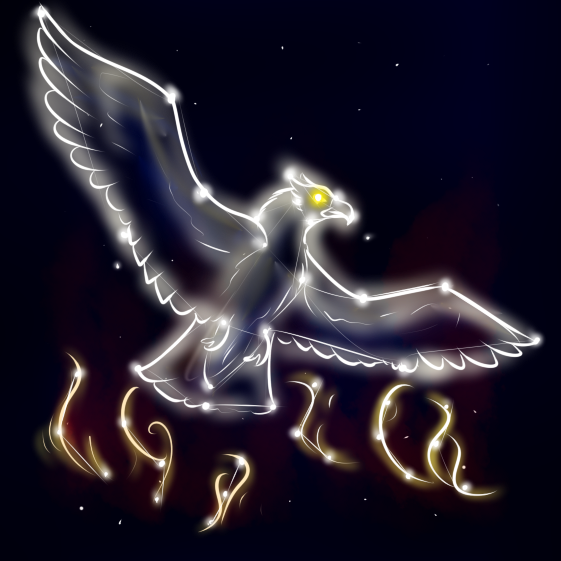
It was perhaps inevitable that the fragile peace on Kurai after the great god-war that had raged upon the Realm and left in such ruin would come to an end not long after it was forged. Shared borders became little better than small-scale battlefields, with raiding parties and patrols frequently skirmishing with one another.
But full-scale warfare didn’t break out until, fittingly and ironically, War Kingdom looked to expand their territory by annexing all of Kidochi. After a period of careful planning, the Kingdom marshalled its armies with great speed and efficiency, and launched a sudden, overwhelming invasion of Pestilence land. Caught unprepared, Pestilence Kingdom hastened to gather together its forces while what soldiers they had near the border were slaughtered or driven back by the relentless advance of War’s host.
Even after their forces were marshalled, Pestilence’s soldiers could only slow War’s advance, their courage and tenacity proving to be no match for War’s discipline and bloodlust. The Kingdom’s poisoners and ages had some notable successes, but even poison and disease failed to stop War’s advance. But the Kingdom’s Lord devised a cunning plan, and ordered his soldiers to fall back, leaving small harassing groups to antagonize and frustrate War’s soldiers.
The rest of the Pestilence army gathered near Ishii-Mero, and carefully prepared the battlefield with various traps. Seeing the chance to destroy Pestilence’s army in one pitched battle, War’s Lord ordered an all-out attack. At first it seemed War would gain yet another victory, but Pestilence had another surprise for their foes. Machin-Shin, the doomed wolves of Pestilence, were unleashed for the first time, exploding into fireballs that unleashed toxic fumes and ignited the equally toxic firepots hidden all throughout the valley.
Confused, disoriented, and suffering under the effects of the toxic fumes, War’s grand army, unable to find their way out of the confusing maze of Ishii-Mero, suffered enormous casualties. War’s Lord, fearing an invasion of the south of Kidochi, called for a truce. The Lord of Pestilence, likewise suffering from a lack of troops after the short but brutal war, agreed. Afterward, to commemorate this victory, Orphethas created a starry image in his own likeness, soaring above a field of flames, as proof of his Kingdom’s resourcefulness and cunning, and a warning that Pestilence was not to be underestimated.
Realm: Lizzarkyth
Created by the long-faded Lizzarkythian gods, this Realm’s constellations are viewed with almost as much veneration as the Realm itself. During certain times of the year, the constellations appear to brighten, and take on a faintly greenish sheen.
The Four Leafed Plant

There was a time, long, long ago, when Lizzarkyth had gods of its own, watching over the Realm and its people. The gods walked among the people, often living and working alongside them in the guise of lizard or saurian for a time before departing. Their bond to the Realm they looked after was deep, and powerful.
As time passed, this bond grew ever more powerful, and ever more enticing as the Realm itself seemed to beckon the gods to join with it. And as time passed, the gods felt more and more drawn to surrender to the Realm’s embrace. They grew more and more distant from their people as they began to lose themselves to the Realm, and merge with it.
However, despite losing their individuality as they merged with the Realm, they remained as compassionate and devoted to their people as ever, and placed the image of a great, four-leafed plant in the night sky as a reminder that they lived on, within Lizzarkyth itself, and would always look after the Realm they loved so dearly.
But time has a way of changing things. Knowledge was lost, and what was once well known slipped into legend, then myth. The gods were all but forgotten, and the people of Lizzarkyth turned to worshiping the living Realm itself, regarding the plant as a sign that the Realm itself was a god, living through the Realm's abundant, rapidly growing plant-life. While the truth is not so simple, they are not completely wrong.
The Great Gold
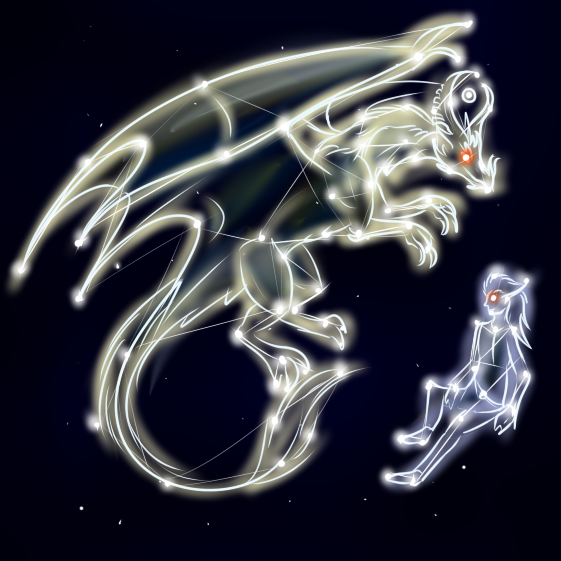
Many centuries ago, a massive golden dragon existed; this dragon's name has been lost to time, and is only known as the Great Gold, a prestigious knight of worldly renown, filled with great power and even greater knowledge. He was a shapeshifter who could change forms, and was the grandfather of our own Queen Verridith. This is but one tale of his vast and numerous exploits... one known most by the lyzards of our allied Realm.
Years ago, the Great Gold decided to visit Lizzarkyth to find the most beautiful and colorful flowers in all the Realms to study and draw. He came not as a dragon, but as a man with long golden hair, and bright scarlet eyes. Upon his arrival, he was treated poorly; a human in the world of the lyzards. They shunned him and tried to force him out of their beautiful Realm, saying that he was tainting its beauty and majesty. The lyzards wondered how the Great Gold had even gotten there in the first place and continued to demand that he leave at once, for they had never before had dealings with humans.
Disheartened by the people of this Realm, he left their capital city and went deeper into the forest. He sought solitude from the lyzards, and wished to find that which he was here to study alone; he transformed into the great dragon and made his way far further than a human might have, before finding the flower he wishes to take note of. Once done, he rose into the sky and flew back around towards the city where the people hated him so.
A young lyzard, just a boy, was the first to see the Gold is this form and began jumping up and down for joy. A dragon had visited them! He went and told his parents, who told the High Priest and word quickly spread of the dragon's coming. The Great Gold was taken aback. These people who treated him so poorly before now loved him, treating him as an object of worship, as dragons were known to be there. He was treated as a god.
It was at that point, the Great Gold turned back into a human, astounding the lyzards once more. The begged the Gold to bring the dragon back and to grace them with his presence, but he denied their request stating that he and the dragon were one in the same. The people were very upset by his refusal and decided to beg for his forgiveness. The apologized for the way they treated him and wished that they could start over and begin a new relationship with the great creature.
And so they did. The people of Alciniron got to know the Great Gold and appreciated him as both a human, and a dragon, feeling foolish for the harsh feelings towards him in the beginning. Now, as a remind of their encounter, during the Winter Solstice, the man can be seen among the stars if you know where to look, as a sign of starting over, new beginnings, and deep trust. As well, during the Spring Equinox, you can see the Gold in his dragon form, a remind of the wonders of dragons that the lyzards worship so heartily.
Shining Unicorn

As the gods of Lizzarkyth continued to merge with the Realm itself, their bodies began to merge with the ground as each of the gods found a fitting resting place for their physical forms. The people they watched over for so long were distraught, left wondering where their gods had gone, and lamenting the absence of their wisdom and knowledge.
Hearing the pleas of their people, the gods, unable to walk among them as they once had, chose Bru'ahn Zaheif, a unicorn with a pure heart, to walk among the people of Lizzarkyth in the name of the gods, bestowing their blessings and sharing their wisdom so the people could learn to rely upon themselves, and pass down the teachings of the gods.
Bru'ahn Zaheif left his herd behind, and spent hundreds of years walking all over Lizzarkyth, passing along the teachings of the gods, even as their voices grew ever fainter as they grew closer and closer to full union with the Realm. The journey was long, and often lonely, as the unicorn’s bond with the gods was unique, and strong enough that he could feel them fading.
One of the last actions the gods performed before fading completely into Lizzarkyth was to create a new constellation. Forever more, the starry image of a unicorn would grace the night sky. What became of Bru'ahn Zaheif after the gods faded remains a mystery. Some say the strain claimed the unicorn’s life, while others believe the unicorn either withdrew into solitude or returned to his herd. A few claim the unicorn still wanders Lizzarkyth to this day, the lone mourner of the gods.
Realm: Millirand
Ancient and obscure, Millirand’s constellations were created by the Ten in days long past. Their original meanings have long been forgotten or distorted. After the withdrawal of the Millirand Five from events, no new stars have graced the Realm’s skies.
The Four Crowns

Long ago, before the existence of the ten gods that now watch over Millirand and Felnova, there was the god whose very soul they all came into being from: the One. The One was a god who was draconic in appearance, and in an attempt to bring balance to the First Realm, he decided to make dragons in his image. So it was done, and the first dragons appeared.
The One also decided upon a special job for one particular dragon: to be the ruler of the whole of Millirand. This dragon was named Kazule, and though he was a fair king, not all of Millirand accepted him. Four human kingdoms – whose names have long been lost to time – banded together with the support of a group of rebellious dragons, intending to dethrone him. The kingdoms did not want to sacrifice their autonomy to a higher ruler, much less a draconic one.
All parties involved in the treasonous plot were confident that their combined forces had enough power to achieve their goal. They were wrong. As they marched upon Jes’re’en where Kazule resided, he rose up to meet them, and a furious battle took place that ultimately resulted in their devastating loss.
What is now the Darklands was once a thriving country. Today, it is a desolate place full of ruins and forgotten history, and no one dares venture into the Darklands to try and salvage its past.
In memorial of the four kingdoms, a constellation was cast into the skies that represented them with a depiction of four crowns. This constellation is generally seen as a reminder of draconic savagery amongst the residents of the Darklands, though it is seen as a symbol of hope, protection and peace to the Remnant dragons; the last organised draconic group of Millirand.
Great Ruler of the Past
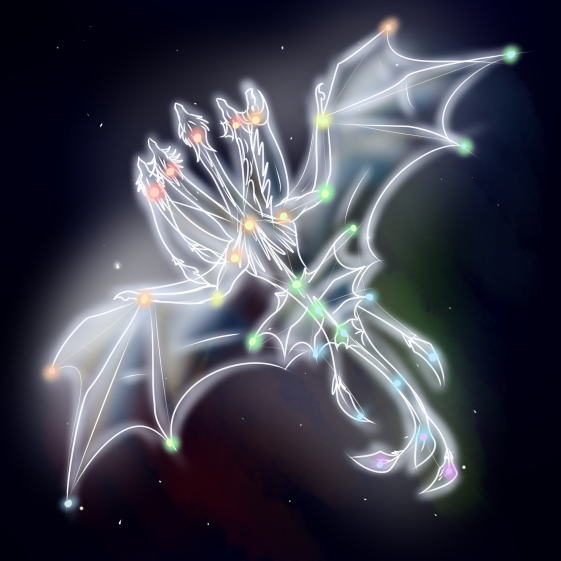
Kazule was one of the very first dragons. Sent with the purpose of ruling in the First Realm – and Millirand after, when the First Realm was destroyed – he ruled for some time, and proved to be a very level headed leader. Not all accepted the draconic reign, however, and both Kazule and Millirand saw war because of it – though his opponents ultimately failed. In his lifetime, the royal also stood in defence against many other threats, successfully keeping his subjects safe.
Eventually, the dragon was chosen to ascend to the status of Ether of the Light Realm, and to lead all the other Ethers of the realms besides, leaving his son Fang to take the throne in his place. As a mark of his initial royal position, and great rule, the gods cast an image of him into the sky – though even today, people are unsure of the dragon.
New Beginnings
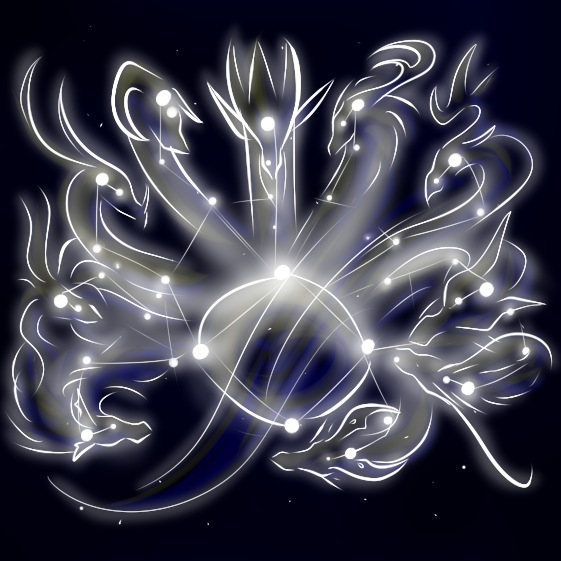
After the first god, The One, died, his body and soul brought forth eleven new beings: the ten gods of the realms that we know today – whose names are Time, Scylla, Leartes, Zacyn, Balion, Fenrir, L’zayn, Gaz’in, Zeldrima and Sago – and a powerful evil, Death. By this point, the First Realm that The One had created was in turmoil, and with the fearsome Death also on the prowl, the ten gods fled to regroup, and form a plan.
In order to defeat the rampaging evil that was Death, the Ten created new life, the First Creations. Among them were the humans, the elves, the werecats, werewolves and weredragons, the aurochs and the eucyon, the unicorns, and the dwarves. Many more were also brought into being by the ten, all with the purpose of fighting evil and defeating it for the good of the future.
Death, however, had a similar plan, and created sarka, basilisks, rathar, vampires, zirus, goblins, undead, nnar’, werebeasts, imps, alicorns, and sirens, all to fight under him in an attempt to crush the light.
When preparations were complete, the Ten clashed with Death, and their armies with each other. So intense was the battle, that the realm itself started to break around them. The balance of the First Realm was torn, and its very Core was exposed. So focused on the fight were the Ten, however, that they did not notice until it was too late. It did seem as though they were winning, but as Time struck down Death when he was too exhausted to retaliate, he too split, as The One’s soul did before.
Death became five separate dragons, known as Dhath, Noamuth, Lithmor, Gurthril and Daecuru, and all five ran, fleeing from the rapidly dying realm. It was only then that the Ten realised that the First Realm was in danger. Pooling their power together, they tried to save it, but ultimately failed.
It was quickly decided that the thing to do would be to make a new realm, for a truly fresh start. Combining their power with that of the Void, the great Hydra who even now helps to uphold the Realms, they gifted the most powerful of the races with godlike power, and made new homes for all, with Ethers to protect them. Millirand was the very first of these, and so a constellation was created to symbolise this.
The Ten and the Five
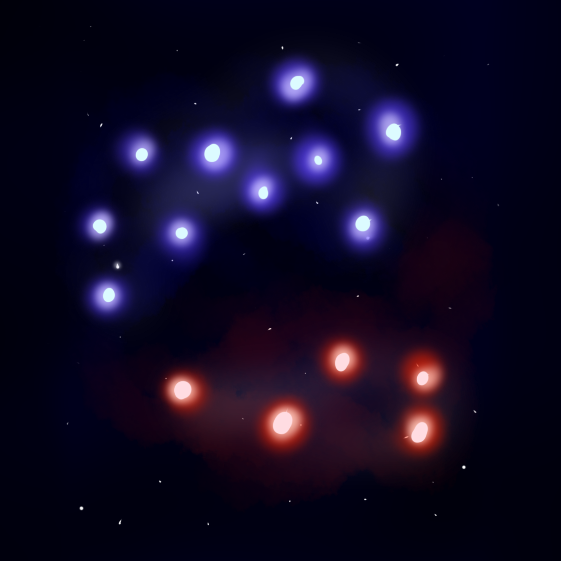
When the first god, The One, died and his body and soul split, ten new gods were made, along with Death. Death later split too, when he was battle-weak, and brought five more dragons into existence. The Ten are known today as the Felnovian Five and the Millirand Five; the Felnovian Five consists of Time, Scylla, Lyfe, Leartes and Balion, whereas the Millirand Five consists of Fenrir, L’zayn, Gaz’in, Zeldrima and Sago. The five gods that were brought about when Death split are known as the Dark Five, and consist of Dhath, Noamuth, Gurthril, Lithmor and Daecuru.
The gods of the Felnovian and Millirand Five are all firmly allied to the side of good, whereas the Dark Five are purely evil. Each one rules and embodies something, and is patron to a specific race.
Time, as his name suggests, is the ruler of time and space, as well as change and energy. He embodies strength, power, and leadership, and is the patron of the dragons. Scylla holds control of the weather and the skies; she is the embodiment of freedom and beauty, and is patron to the elves, drow, and the avians. Lyfe rules over space itself, and is in charge of the sun, the moon and the stars. He embodies ritual, wisdom, and prosperity, and is the patron of both argent and aurem lions. Leartes reigns over war and peace, embodies balance, decision and solidarity, and is patron to elementals, and Balion is ruler of nature, growth and the earth who embodies energy, persistence, and optimism, and is the patron of dwarves.
Fenrir is the ruler of justice and light, embodies judgement, justice and virtue, and is the patron of humans. L’zayn rules over healing, is the embodiment of sorrow, healing, and warmth, and is the patron of unicorns. Gaz’in reigns over scholarly learning, embodies speed, intuition, and learning, and is patron to the centaurs. Zeldrima is in charge of luck and starlight, and is the embodiment of luck and fortune. Sago is the ruler of water, the seas and the rivers, embodies emotion, grace, and negotiation, and is the patron of sea-serpents and merfolk.
Finally, within the Dark Five, Dhath rules over shadows, despair and darkness. He is the embodiment of murder, wrath, and danger, and is patron to the sarka. Noamuth reigns over greed and darkness, and embodies desire, greed, and cunning, as well as being the patron of the basilisks. Gurthril rules over pride and ill-fate, embodies pride, prejudice, beauty, and vanity, and is patron to vampires. Lithmor is the ruler of gluttony; he embodies gluttony, lust and torture, and is patron to the alicorns. Daecuru reigns over wrath, embodies wrath, anger and hatred, and is the patron of the undead.
Realm: Noctis
Either crafted by Seiten alone, or by her with some assistance form one of the Greater Gods, Noctis’ constellations are one of the few things that draw the Sea Peoples up from the depths. They are unique in the contrasting blue and white stars that form them.
Lion of Fire

All know of the twin lion brothers, gods both, Azcen and Nebrielas; but there is a tale of another lion, perhaps divine and perhaps not… but one well known to the people of Noctis. Legend tells of a great lion with a dark coat of blue and an onyx-black mane, silver eyes, sometimes depicted with wings and sometimes not. However, other depictions tell of a great golden lion covered in fire; and both of these depictions have differing names. One is the lion Kerberos Silverblaze, and the other is Leo Nemari. Both are complete and utter masters of fire, the likes of which is rarely known.
Some say that Leo and Kerberos are the same. This lion is a champion of the people, and has been known to work with other masters of fire for a variety of reasons. In Noctis, an island burns with all varieties of fire; the great Fire Lion once came here, to what is now known as the Isle of Kerberos, to rest and recuperate from the trials of the world. He is the lion that taught the ancient peoples of Noctis in the art of fire; he gave us the gift of flame, the Great Leo, and taught our mages the basics of the many types that can be made by infusing one’s will and reiatsu into their fire, changing the properties of what it is and what it might be.
Whether or not Kerberos and Leo are one and the same, many in Noctis do not care. Though the knowledge of the Lion’s arcane fire has been largely lost, the Isle remains to remind us of what once was, and the spirit of Kerberos - or Leo - is everlasting as the moons.
Great Kraken; Drowned Isle

The Sky and the Sea were once content to live in quiet indifference towards one another, each keeping to their own domain. Seldom did they ever break this isolation, and even when they did, everything soon returned to the way it had always been. However, it was not to last. Perhaps they were too different. Or too similar. Whatever the reason, Sky and Sea became embroiled in a long, bloody war.
Regardless of who may have started it, or who was to blame for tensions to erupt into open war, the resulting conflict evolved into a war of conquest, with the Sky Peoples seeking to gain full dominance over the Sea, while the Sea Peoples fought just as hard to resist the Sky, seeking to crush their power. The fighting was brutal, turning into a war of attrition, until the mages of the Sky domains prepared a conjuring of immense power.
They split the sea, allowing their soldiers to strike at the normally unreachable cities beneath the ocean’s surface and proving that they could strike when and where they wished. But, while the Sky reveled in their achievement, little did they know that in their arrogance they had committed a grave folly. Their conjuring had disturbed an ancient creature, slumbering in the depths.
Disturbed by the splitting of the sea, and enraged at the perceived invasion of its domain, a great kraken emerged from the depths, unleashing its fury and unfathomable might against the sky. Hurling great rocks ripped from the sea floor at the floating islands of the Sky Domain, and striking at the Sky-Knights and other soldiers daring to face it in battle with its mighty arms, it caused great destruction before it abruptly sank beneath the waves once more, leaving the Sky to cheer, believing they had won a great victory.
But their cheers were soon cut off as the kraken resurfaced to strike one last time. It seized a floating island, upon which the city of Pelaris stood, and dragged it and all its inhabitants unable to escape, beneath the waves, where it remains to this day. Shocked and dismayed by both the tragedy of Pelaris and the unrivaled might of the great kraken, the Sky Peoples negotiated a truce with the Sea Peoples.
That night, there appeared in the sky a bright grouping of stars depicting a great kraken with an island gripped in its arms, serving as a stark reminder of the destruction the long war had wrought upon Noctis, and the legions of lost lives.
The Great Divide

Noctis has long been a divided Realm. Just as there is no land between sky and sea, so there is no bond between Sky Peoples and Sea Peoples. For many years, they lived in complete indifference towards one another, the Sky Peoples content to dwell upon their floating islands and continents, and the Sea Peoples content to live beneath the sea.
However, there were some from both sky and sea who were curious about their neighbors, and sought to meet them. At first, these meetings went well enough, but over time, this growing familiarity began to breed contempt. Tensions began to arise, and eventually led to sporadic violence as various skirmishes occurred.
Legend has it that Seiten sent two Wards to live among the people, and keep the peace. For a time, this had the desired effect, as tensions calmed, and the Sky Peoples and Sea Peoples largely went back to ignoring each other. All seemed well. But sadly, it was not to last. Under Albion’s influence, tensions began anew, and it looked like war was inevitable.
However, there appeared in the night sky a new group of stars, representing a towering mountain range opposite a mighty ocean wave, with a great chasm between them. This was Seiten’s reminder that, though the two were so different, they were still a part of the Realm’s balance. Equal and opposite. While war was averted for a time, the peace didn’t last. Peaceful coexistence on Noctis remains elusive.
Realm: Ristell
Ristell’s constellations were created by the Realm’s gods, and are often made dim by the light of the Moon That Never Sets. These constellations play a large part in a number of ceremonies and rituals all across the Realm, although they are largely viewed with disdain by the Undergrounders.
Eye of the Pharaoh

The Royal Sphinxes of Ristell might be some of the wisest rulers in the Realms, but there was a day when they came close to tearing Arcadia apart in a bitter struggle for power after Khafra, the reigning pharaoh, died, struck down by an assassin, without leaving a designated heir. He was immortal, and still in the prime of his life, so his abrupt death came as a shock to all.
After the pharaoh’s death, his son Hannu claimed the right to the throne, while his uncle Sharek, brother of Khafra, opposed him, claiming he had the greater right. Their dispute left the family bitterly divided. The pharaoh’s son was young, and full of life, and already a proven warrior and leader. However, his uncle was more powerful, and considered to be a warrior without equal, save for the Divines.
When words failed to sway either of them, they came to blows, each determined to win the throne by right of combat. During their fight, the Hannu had his left eye ripped out, and although he had been outmatched for much of the fight, he struck out in a blind fury, and came close to disemboweling Sharek. They were both forced to call their fight a draw, and withdrew to tend their wounds.
The prince’s mother Isesu tended to his eye, and used her magic to cause it to regrow. However, while it worked just as well as before, it regrew a vivid blue color instead of the golden shade it was before. While she tended his wounds, she revealed a secret she had uncovered. The pharaoh had been slain by his own brother. Shocked, and enraged, the prince vowed to see justice done.
Hannu confronted Sharek once more, this time accusing him of murder in front of the entire royal court. While his uncle at first denied it, Isesu entered, along with the spirit of the dead pharaoh, who confronted his murderer, and condemned him to exile. Stripped of his royal titles, and authority, Sharek was cast out into the desert to be forgotten.
Hannu was crowned Pharaoh, and under his rule, Arcadia entered a golden era of peace and prosperity. It is said that the same night he ascended the throne, the starry outline of a seated sphinx with a bright blue eye appeared in the sky. Whether this is true or not, it is clear that the gods had bestowed their blessing upon Hannu, and made it known to all.
Azcen's Blessing

Long ago, in ancient times, Arcadia was not a unified country. Numerous tribal chieftains and petty kings ruled over small portions of the land. Law and order were was only sporadically enforced and frequent power struggles occurred between cities, and between cities and tribes. Thus it had always been, and thus it appeared it would always be.
However, in the city of Eden, a sphinx named Neheb was born. Gifted with the Sight, he foresaw a unified empire that could rule over all of Ristell with power and wisdom, and be a bastion of gathered knowledge for all the Realms. Through a mix of prowess in battle and sheer force of personality, he gathered support for himself and seized control of Eden with little resistance, and established himself as a king.
Over the next several decades, he used negotiation and intrigue, and war when necessary, to bring the rest of Arcadia under his rule, organizing the once-chaotic land into a strong empire. Once he had the entirely of the Arcadian Desert and its people under his authority, a period of peace and prosperity began, marred only by a brief, inconclusive war with the Empire of Nyx, and a rather disastrous expedition into the southern Wilds.
Over the next several centuries, Neheb negotiated treaties with Nyx, the Merfolk, and the dwarves of Dun Modon. However, despite all of his accomplishments, he began to worry about the future. Immortal though he was, he couldn’t reign forever. So, he turned to the gods, and humbled himself before the Altar of Azcen, praying for a blessing upon not himself, but on his successors, so that the Arcadian Empire would endure.
Azcen manifested in the form of a great, fiery lion, and placed a golden crown upon Neheb’s head, giving him a divine blessing before vanishing. That night, a starry lion holding a crown appeared in the night sky, symbolizing the god’s blessing upon the royal family of Arcadia, and reminding them where their authority came from. For what Azcen gave, he could take away if he was displeased.
Realm: Xaeri
Crafted by the Realm’s gods in ancient times, the constellations of Xaeri are vibrantly colorful, and the subject of many celebrations among the native xeriin. Widely regarded as some of the most beautiful constellations in all the Realms.
Unity and Grace
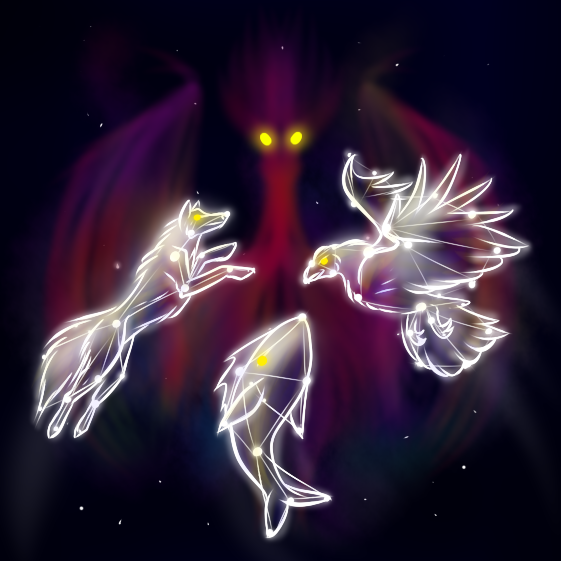
The xeriin have longed live together in peace and harmony, not caring about the differences between Ocean, Sky, or Forest-Kin. In days long past, the Myth-Kin shared this same sense of trust and fellowship. But, over time, as the various Kin groups began to gather together according to their own types, the xeriin began to worry that they were splitting apart, and losing the unity they had enjoyed for so long.
In response, the gods chose wards from among the Kin, an eagle-xeriin from the Sky-Kin, a wolf-xeriin from among the Forest-Kin, and a fish-xeriin from among the Ocean-Kin, and tasked them with wandering among the various settlements, keeping the bonds they shared strong and fresh. There rumors that, in the early days, a Myth-Kin was chosen as well, but what this one may have looked like remains unknown.
After some time, to further reinforce the feelings of unity, a new constellation appeared in the night sky, showing an eagle, wolf, and fish together, against the backdrop of a shadowy nebula which was said to represent the Myth-Kin. While in the early days the Mythic types were said to represent the ties between types, as only the Myth-Kin crossed the normal types, sadly, the xeriin have grown to view it in a different light.
The Myth-Kin are now reviled, unwelcome among the rest of the Kin, either driven away or hunted down and killed. The shadowy nebula is today viewed as representing a threat the Forest, Ocean, and Sky should stand united against, and many xeriin treat the old story about a Myth-Kin ward to be nothing more than a story without any truth to it.
Blessed Wings
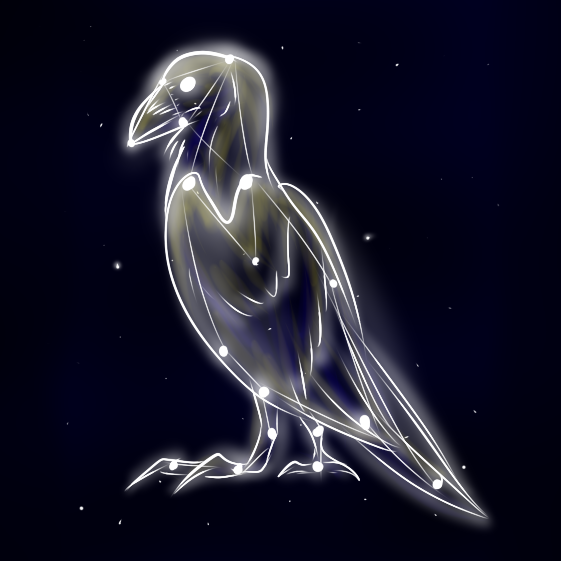
Long, long ago, in ages long past, the xeriin lived as they willed, wandering and living where they would. Their lives were simple, and they were content with things as they were. Sky-kin lived alongside Ocean-Kin and Forest-Kin without issue, and in those days even the Myth-Kin walked among them freely. But as war and betrayal put an end to their idyllic lives, scattered as they were they were hard-pressed to react to the various crises facing them.
Amidst the chaos, the raven-xeriin Ralti emerged as a smart, charismatic leader, using her wit and rhetoric to draw other Sky-Kin to her cause. Under her leadership, they began to organize themselves into more than just scattered groups of wanderers and remote villages. They became a true nation, looking to Ralti for guidance.
She led her people into the mountains of the land that came to be called Kerguelan, where they established various settlements in the mountains. These mountain dwellings provided them with easily defended homes where they could live in peace. But while Ralti had established Kerguelan with the Sky-Kin in mind, she welcomed Forest-Kin and Ocean-Kin just as readily, and formed a strong bond with the local saurian.
Her reign was long and peaceful, firmly establishing Kerguelan as a lasting domain, and she was greatly respected by xeriin and saurian of all types. In her final years, she relinquished power, ensuring a smooth transition of authority, and withdrew from public life entirely. Some say she lived long enough to see the great, starry raven-xeriin that appeared in the years following her abdication, while others believe the starts only appeared after she passed away. But whatever the truth may be, those stars will serve as an ever-present reminder of all she did for her people.
Forest Quietude
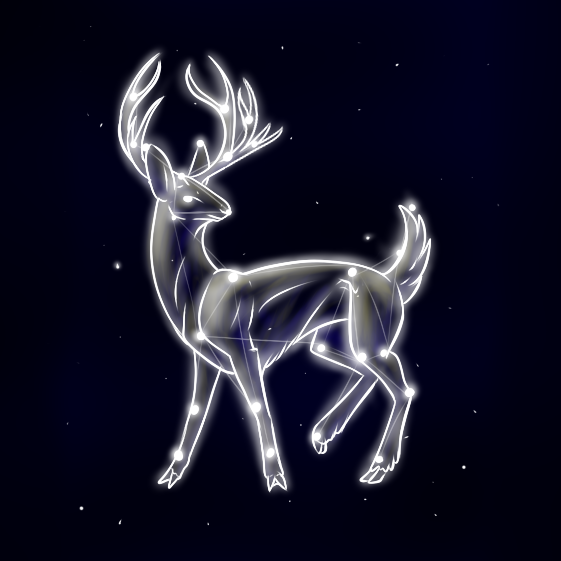
In ancient times, the xeriin lived as wanderers, with scattered, remote villages serving as the only settlements. Forest-kin, Ocean-Kin, and Sky-Kin lived side by side in harmony, and even the Myth-Kin dwelt among them freely. But this peaceful existence was not to last, as war spread to Xaeri, and forever changed the lives of everyone in the Realm.
While the Sky-Kin moved to the mountains, and the Ocean-Kin withdrew to the sea, the Forest-Kin gathered together in large numbers for the first time in the Realm’s history. Among their number was a deer-xeriin named Hurst, who had lived for several centuries and gained a wide-spread reputation for his great wisdom, and the rest of the Forest-Kin began to look to him for answers.
Reluctantly, Hurst took on a position of leadership, and gathered together the wisest and most respected from among the ranks of Forest-Kin so they could discuss what should be done. After several days, under Hurst’s guidance they realized they had to come together as a nation, not just a collection of similar but separate bands of wanderers. They headed east, into what would one day be Erurost, and settled into a more unified way of life.
However, Hurst refused to be seen as a ruler, opting instead to wander among the various Forest-Kin settlements, leaving the various local rulers to govern themselves. However, Hurst’s words were always respected, and only rarely would anyone refuse to heed his council. Eventually, he withdrew into Lightgrove Forest, becoming an increasingly elusive hermit. It was some years after he was last seen that a great, starry image depicting a deer-xeriin appeared in the night sky, and every Forest-Kin xeriin knew without a doubt who those stars were meant to honor.
Ocean Deep

In days long past, Ocean-kin, Forest-Kin, and Sky-Kin wandered freely among one another, forming only small settlements scattered far and wide, living where they would, often alongside the saurians who shared their world. Had their lives remained forever thus, they would’ve been content. But sadly, it was not to last. War came to Xaeri, and the xeriin way of life changed forever.
Seeking refuge in the depths of the sea, the Ocean-Kin faced an uncertain future. Many, fearful and cautious, wanted to simply remain in the ocean, where they would be far safer if another war were ever to happen. However, a powerful dissenting voice opposed a life of isolation. A whale-xeriin named Brundell, already well-respected for his stolid, unwavering steadfastness in the face of crisis, spoke against such total isolation.
His large, imposing stature, even in his human form, only served to add to his authoritative words. When the rest of the Ocean-Kin turned to him for answers, he was at first surprised, but accepted the leadership role he had thrust upon him with the same unwavering way he faced everything else in his life. Under his direction, the Ocean-Kin founded several settlements of various sizes beneath the waves, and reestablished contact with the rest of the xeriin. Brundell himself personally oversaw the founding of Harmony, established to be a fitting home for xeriin of all kinds, and their saurian friends.
Brundell lived well over one thousand years, and remained an active leader well into his final years, when he officially gave up all authority in Cimmeria, the land he had founded, organized, and molded into a prosperous nation. But he remained a close advisor to the land’s rulers, and when he passed into the afterlife, his presence was deeply missed. However, amidst the mourning, the new grouping of stars that appeared the same night he passed away brought joy to the xeriin and saurians. The great whale would forever be remembered, and revered.
